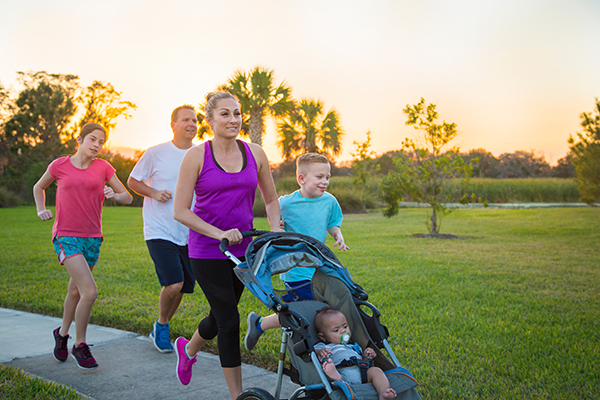
- Walking three times a week for 60 minutes reduces dementia risk by up to 60%, especially for APOE e4 carriers.
- The 6-6-6 challenge—60-minute walks starting at 6 a.m. or 6 p.m.—encourages consistency but may not fit all lifestyles.
- APOE e4 gene carriers showed slower cognitive decline when walking, per a study presented at the 2025 Alzheimer’s conference.
- Experts stress personalization: Safety, flexibility and gradual progress are key to long-term adherence.
- Walking boosts brain-protective proteins like BDNF and improves blood flow to delay memory loss.
The 6-6-6 walking trend: A framework for consistency
The 6-6-6 challenge, promoted by fitness brands and online influencers, advocates a rigorous yet straightforward regimen: walk 60 minutes three times a week, starting at 6 a.m. or 6 p.m., with six minutes of warm-up and cooldown. Christopher Gagliardi, a certified personal trainer, describes it as a “marketing-driven motivational tool,” while experts acknowledge its potential to counter low adherence rates in sedentary populations. “The 6-6-6 framework is beneficial for those who need psychological externally imposed structure,” says Raj Desai, MD, a pain medicine specialist. However, the challenge isn’t universally ideal. “A 60-minute daily commitment is significant,” noted Desai, citing struggles among patients to manage even 30 minutes. Natasha Bhuyan, MD, a family physician, adds that flexibility is critical: “The best exercise is the one you’ll stick with.”Walking’s genetic edge: Why it matters especially for APOE e4 carriers
The study presented at the Alzheimer’s Association International Conference linked walking to significant cognitive benefits, particularly for those with the APOE e4 gene. The variant, carried by 14% of the population, is strongly associated with late-onset Alzheimer’s. Analysis of data from nearly 3,000 older adults revealed that APOE e4 carriers who walked regularly had slower cognitive decline than those who did not, even after a decade. “Exercise acts as a metabolic ‘reset switch’ for individuals at high genetic risk,” explained lead author Cindy Barha, PhD, noting that walking stimulates brain-derived neurotrophic factor (BDNF), which strengthens neural connections. “It’s like fertilizer for your brain,” she emphasizes, pointing to improved hippocampal health, the brain’s memory center.Beneath the numbers: How walking combats cognitive decline
While the 6-6-6 challenge provides a template, its success hinges on the science behind its structure. Walking boosts cardiovascular health, improves blood flow to the brain and triggers neuroprotective proteins. According to Barha, even short, daily walks—like the study’s participants who walked ten blocks (one mile) a day—cut cognitive decline risks by 13%. Yet historical context matters. As baby boomers age and Alzheimer’s care costs balloon, researchers have shifted focus to prevention. “Birth rates post-WWII mean we’re now confronting an aging population crisis,” said Jessica Langbaum of the Banner Alzheimer’s Institute. “Lifestyle interventions are scalable solutions lacking in side effects.”Making it work: Tailoring a routine for all bodies
Health experts agree that no single program fits all. For sedentary individuals or those with joint issues, the 6-6-6’s intensity may be daunting. Starting smaller, like 10-minute strolls multiple times daily, can build endurance. Wearable tech, music, or walking with friends—strategies endorsed by the CDC—can boost motivation. “The beauty of walking is its democratization,” says Tim Smith, a fitness app trainer. “You don’t need a gym but need to prioritize it.” Safety remains paramount. Gagliardi cautions against overexertion for beginners or those with injuries: “Listen to your body. Don’t push through pain.” Guidelines recommend consulting a physician before major changes, especially for those with heart or mobility concerns.Walking as a prescription for the future
As the world grapples with dementia’s rise, these studies offer a hopeful, actionable blueprint. By embracing walking—whether through trends like 6-6-6 or personally tailored routines—individuals can mitigate risks, even if their genetics stack the odds against them. “The brain is plastic—even at 70, it can rewire,” Barha said. “Walking is these findings’ most profound takeaway: We have power over our cognitive destiny.” Sources for this article include: EverydayHealth.com MedicalNewsToday.com EverydayHealth.comDiscovering balance: “The Way of Ayurvedic Herbs” unveils ancient healing wisdom
By Belle Carter // Share
Why fear the specter of cancer when ANTIOXIDANTS are readily available?
By Lance D Johnson // Share
From ancient elixir to modern superfood: The timeless power of Goji Berries
By Ava Grace // Share
Trump’s MAHA commission delays landmark report amid health policy overhaul debate
By Willow Tohi // Share
Gary Null’s “Healing Your Body Naturally” explores the frontiers of alternative medicine
By Kevin Hughes // Share
A viral video ignites federal firestorm over Minnesota fraud
By willowt // Share
Russia activates "unstoppable" Poseidon tsunami drone
By kevinhughes // Share
Russian FM Lavrov: Moscow will back China on Taiwan issue
By ramontomeydw // Share
The breakfast clock: Why timing your morning meal is a secret weapon against high cholesterol
By jacobthomas // Share
The Health Ranger's New Year Revolution: The ultimate guide to health, wealth and freedom
By kevinhughes // Share
"Absolute Healing" on BrightU: Experts explore COVID-19 as an engineered bioweapon
By jacobthomas // Share











